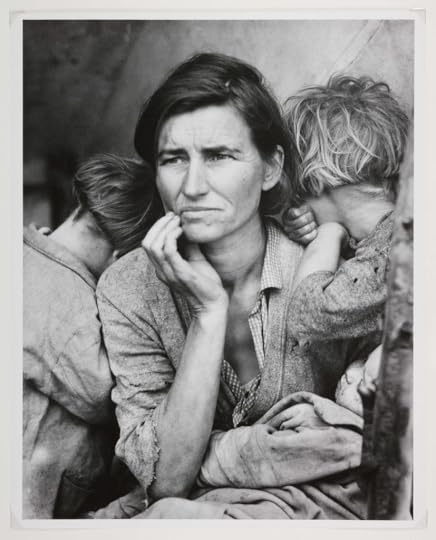
In 1936, documentaryphotographer Dorothea Lange took a picture that has become the symbol of theDepression. The photograph, taken in Nipomo, California, shows a woman sittingin the back of a beat-up truck, holding an infant, with two other childrenhuddled close to her but turned from the camera, as though blocking it out. Thewoman stares into the distance, her face lined with fatigue, hunger, and anxiety.She and the children are dirty, their clothes obviously worn for days. It is apicture of abject poverty and hopelessness. Lange worked for the Farm SecurityAdministration and did not own rights to the photos she took; she was paid asalary and never profited directly from the immense popularity of this image.Nor did she get the subject’s name or permission. A few days later, thephotograph was published in the
San Francisco News. The subject of thephoto remained anonymous.
In 1978, a woman namedFlorence Owens Thompson wrote to the Modesto Bee identifying herself asthe woman in the portrait. She and her family felt used by the photographer,disputed some of the facts that had grown up around the picture, and resentedbeing symbols of the Depression. Thompson, who was full Cherokee from Oklahoma,eventually had several husbands and partners and as many as nine children (therecord is a bit unclear). In 1983, her health failed, and her children askedfor donations to cover her medical care, collecting several thousand dollars.She died a few months later at the age of eighty.
Knowing none of the story, Ifirst saw the picture years ago and was struck by the anguish on Thompson’sface. What I wondered would bring some joy and hope into that life. I wrote ashort story, “Sue Ellen Learns to Dance,” in which I plucked her out of theDustbowl and gave her a new life. The story won a Wrangler (Western Heritage)Award from the National Cowboy Museum and a Spur from Western Writers ofAmerica.
This past week I read a novel,Mary Coin by Marisa Silver, also based on the life of Florence Thomson.Silver uses three voices to tell the story---that of Mary herself (Thompson), photographerVirginia Dare (Lange), and a college history professor named Walker Dodge whoappears to be the only purely fictional addition to the story. Silver lays outa plausible life for Mary Coin—more marriages, more children—that ends with herliving alone in a trailer, despite nicer accommodations arranged by her protectivechildren. The three voices speak interchangeably, and I was uncertain early on wherethe novel was headed, though I had a suspicion. The characters are portrayedsympathetically, and the entire work is a graphic account of the hardships ofthe lives of migrant farm workers in the 1930s. There is also a lot of angstand much introspective wandering in the minds of these three characters, buteventually it ends with a climactic plot twist that takes real liberties withtruth and possibility.
A friend and fellow novelistasked me what I thought about the differences between my story and Silver’snovel, and at first, I dismissed it as the romanticist (me, with a happyending) against the realist (with a heart-wrenching though contrived ending).But the more I thought on the question, the more I realized that Silver took aspecific woman and created a plausible, probable if grim life story for her.That is or should be historical fiction.
I saw the beleaguered woman assymbolic of the many migrant mothers and imagined a future rather than tryingto stick to reality. There were other threads in my story—a hint of Faulkner’s AsI Lay Dying (a dying grandmother is central to the resolution) and woven inis the theme often found in western stories about the good woman who cherishesmemories of an outlaw lover or a wild escapade in her past. Though it takesplace in the past, I see it as fiction without the historical qualifier.
I wonder if readers would seethe same difference I do. Anyway, I find it fascinating that almost ninetyyears later, that iconic photograph is still inspiring writers.
Sue Ellen Learns to Dance and Other Stories - Kindle edition by Alter, Judy. Literature & Fiction Kindle eBooks @ Amazon.com.
 newest »
newest »
 newest »
newest »
 It's always been a haunting photo. I would love to read the short story inspired by the photo that you wrote, Judy. Where can I find it?
It's always been a haunting photo. I would love to read the short story inspired by the photo that you wrote, Judy. Where can I find it?





